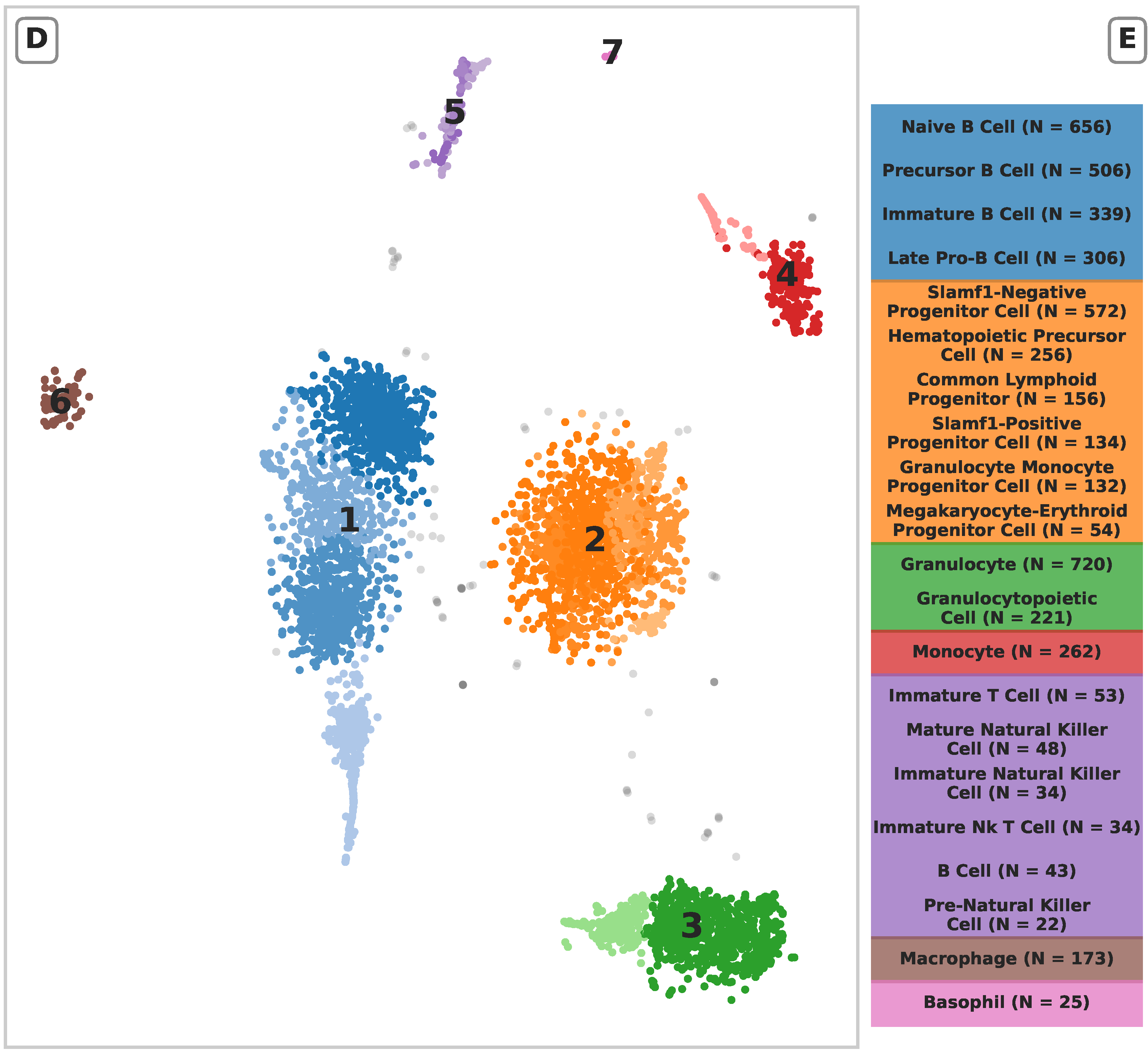Current research areas:
Quantitative and Computational Biology
In recent years tremendous growth has been seen in the amount of quantitative information available in the biological sciences. New high-throughput experimental technologies have matured and are being combined in creative ways to explore living systems in ways not envisioned previously. We are working to build dynamical models based upon this data that can accurately describe biological systems and, ultimately, provide an understanding of cause and effect in them.
An example project is the development of EMBEDR, an algorithm that assesses the output of any dimension reduction (DR) algorithm to distinguish evidence of structure from algorithm-induced noise. We applied EMBEDR to DR-generated representations of single-cell genomics data of several modalities to show where the DR algorithms show real structure and when that structure is spurious. The figure below shows the result of EMBEDR applied to Tabula Muris data. The clusters produced by EMBEDR and better defined than a straightforward application of traditional DR methods.

Such results are the goal of the National Institute for Theory and Mathematics in Biology.
Computational Neuroscience
We are currently collaborating with the Gallio laboratory to develop models of temperature sensing and preference in the fruit fly Drosophila. These studies have involved computational modeling of neurons in the thermosensory circuit, analysis of sequencing data from neurons in the circuit, and the development of models of behavior based upon what has been learned from studies of neurons in the circuit and electron microscopy reconstructions of their connectivity.
The figure below is an animation of a fly navigating in an arena and avoiding two hot quadrants, and a simulated fly (a "vehicle") based upon realistic neuronal circuitry.

For a number of years I collaborated with Nelson Spruston (Janelia Farm Research Campus) to investigate microcircuits composed of principal neurons and interneurons in the CA1 region of the hippocampus. Computational models have been developed based on current data from ongoing experimental studies, such as patch-clamp experiments measuring ionic conductances, calcium imaging, and full-cell morphological reconstructions.
The figure is an animation from a NEURON simulation of synaptic input in a CA1 pyramidal cell. First, distal input (indicated by the arrow) initiates dendritic spikes which fail to propagate to the main cell body (the soma). Next, more proximal Schaffer collateral input occurs; this generates dendritic spikes in the radial oblique side branches, but produces only subthreshold activity in the main apical dendrite. Finally, both inputs are activated simultaneously; in this case, the depolarization from the more proximal input "gates" the distal dendritic spikes, allowing them to propagate to the soma and produce a somatic action potential. For more details, see T. Jarsky, A. Roxin, W. L. Kath and N. Spruston, Conditional dendritic spike propagation following distal synaptic activation of hippocampal CA1 pyramidal neurons, Nature Neuroscience 8 (2005), pp. 1667-1676.
We also collaborate with Daniel Dombeck's lab to model the behavior of hippocampal neurons in the brains of mice as they learn to navigate within a virtual maze.

Historical research areas:
Optics

Simulated eye-diagram for a 10 Gb/s DPSK system indicating the probability for the received voltage to have a particular value at any given time. The colorbar on right gives the logarithm (base 10) of each color.
Previously we developed mathematical modeling of high bit-rate fiber-optic communications. We studied linear and nonlinear pulse propagation in optical fibers, including solitons. One emphasis was the application of parametric amplification to optical fiber systems and devices; this work involved the modelling of experiments performed by Prem Kumar's group at Northwestern.
We also used importance sampling and related methods to investigate the significance of rare events in lightwave transmission systems. Studies have considered polarization mode dispersion (PMD), amplitude and timing jitter in soliton transmission systems caused by amplified spontaneous emission (ASE) noise, and phase jitter in differential phase-shift keyed (DPSK) systems.
Publications
|
Example quantitative biology publications:
Example neuroscience publications:
Example optics publications:
|
Group
Current graduate students: Richard Suhendra (jointly advised); Nan Ding (jointly advised).
Former graduate students: Ziyu Zhao (jointly advised), Eric Johnson (jointly advised), Joshua Levy (jointly advised), Nathan Sanford, Brit Schneiders Young (jointly advised), Hannah Choi (jointly advised), Danny Wells, M. Cembrowski (jointly advised), A. K. Hobbs, D. J. Muraki, T. Ueda, C. V. Hile, J. N. Kutz, A. Gloag (nee Niculae), M. J. Mills, B. S. Marks, R. O. Moore, S. K. Bhatt, E. T. Spiller, M. S. McCallum, V. Menon, G. Donovan, R. Trana, Y. Katz (jointly advised)
Former undergraduate students: A. D. Kim, S. L. Sweatlock (nee Fogal), A. C. Narayan
Former postdoctoral associates: Daniel Poll, Aushra Abouzeid, C. G. Goedde, T.-S. Yang, G. Biondini, T. Horikis, J. Li